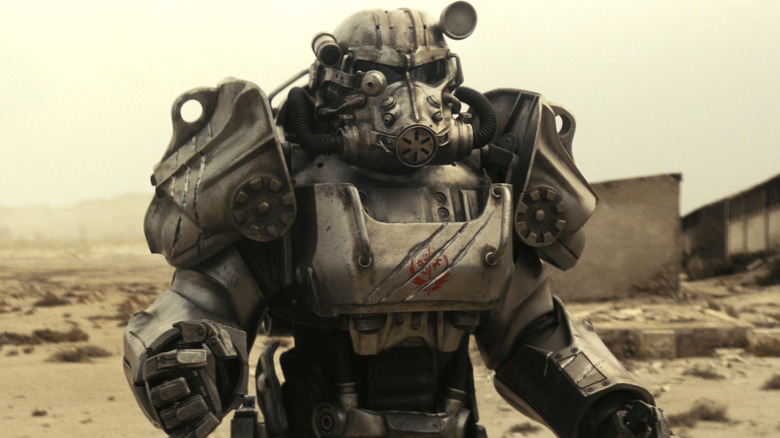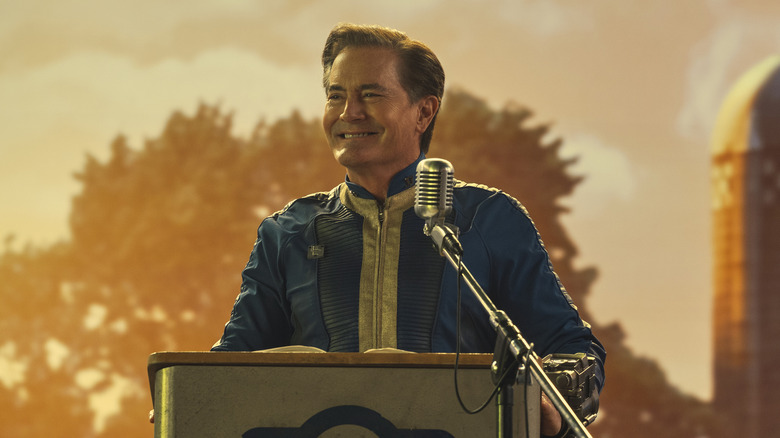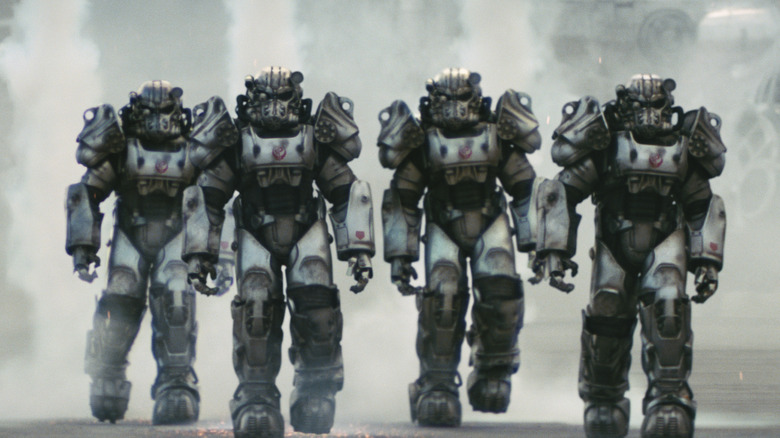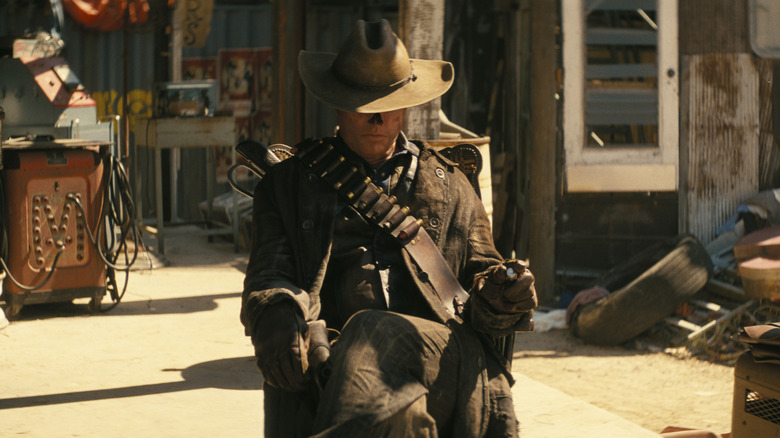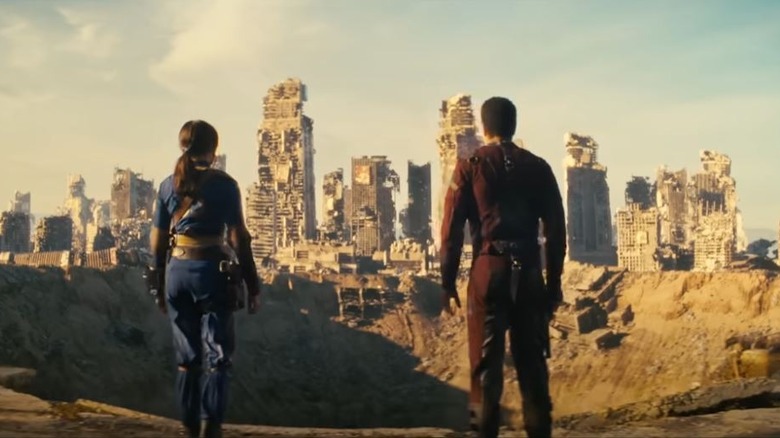All 4 Fallout Factions, Explained
Contains spoilers for "Fallout" Season 1, Episode 8
Amazon Prime's "Fallout" Season 1 tells an original story set in the radioactive wastelands around what's left of Los Angeles while staying true to the "Fallout" games' overall aesthetic and backstory. As such, the characters on the show may be new, but the various factions they're affiliated with should be familiar to everyone who's played the games — at least superficially.
From the Vaults of Vault-Tec to the power armors that make the Brotherhood of Steel so formidable, the various visual elements associated with each major "Fallout" faction are certainly easy enough to recognize. But how familiar are you with the groups themselves? What's their core mission in the post-apocalyptic wasteland? Are they in good standing among the scattered survivors, or feared and hated for their actions? Let's take a look at what the four main factions on "Fallout" are all about.
Vault-Tec builds Vaults, drops bombs, performs horrific experiments
Amazon Prime's "Fallout" unfolds Vault-Tec Corporation's true horrors at the same pace it reveals the terrors of the Vaults themselves. When the "Fallout" series exits the Vault for the first time, Lucy (Ella Purnell) thinks the giant shelter offers the best possible way of life in the post-apocalypse. By the time the show ends, the seemingly benevolent Vault-Tec is fully revealed as a shameless capitalist venture that created the Vaults to outlast the competition, sold them to various interested parties to use for human experiments, and is very heavily implied to have deliberately caused the nuclear apocalypse. What's more, Cooper Howard's — played by Walton Goggins, who's unrecognizable as a ghoul — wife (Frances Turner) is in on the company's very worst plans in the show's 2077 timeline.
In the games, Vault-Tec is a similar enterprise, though the evil Vault experiments aren't entirely of their own doing. Instead, the corporation is simply an oppressive business with a big PR budget, and a shadowy secret society of government higher-ups known as the Enclave is responsible for turning the Vaults into experimental horror. Likewise, the game version of the apocalypse is caused by the Great War between the United States and China, and Vault-Tec has nothing to do with it. As such, the Vault-Tec Corporation of the show is actually even worse than the one in the games.
For those in the know, that is. While the majority of the people seem to be aware of the Vaults, they tend to consider the people in them clueless at best and doomed at worst. Along with her inexperience, this is a significant problem for Lucy, who tends to be treated as a joke by most other characters until she learns the ways of survival herself.
The Brotherhood of Steel collects tech and absolutely will not share
As the show is quick to let viewers know, the Brotherhood of Steel – aka "Fallout's" resident military faction with the cool power armors — is all about two things: rigid hierarchy and salvaging technology. Unfortunately, they aren't too keen to share their discoveries. Where the Brotherhood has state-of-the-art combat gear, cool airships, and enough supplies to feed and equip a literal army, your average wasteland denizen is still wandering around in rags and struggling to survive. In fact, the Brotherhood seems to be quite an exclusive bunch — so much so that the people who bump into them are understandably wary and even fearful.
The game version of the Brotherhood is essentially the same thing, with a deep history, culture, and even belief systems. Depending on the local faction's leaders and the player's alignment, they can be staunch allies or formidable adversaries.
While the show's Brotherhood skews toward villainous and power-hungry, Season 1 has only begun to scratch the surface of this complicated faction. Hopefully, possible future seasons of "Fallout" will delve deeper into the lore — or at the very least bring the Brotherhood's cool giant mech, Liberty Prime, into the mix.
Ghouls are a faction, whether they like it or not
Ghouls make "Fallout" a prime example of a post-apocalyptic show where the creatures aren't actually zombies. They're also a bit of a special case since they're not so much a faction as they are a completely new, post-apocalyptic type of people. Unlike their appearance might suggest, the "Fallout" ghouls aren't undead. Instead, they're merely mutated by radiation and other factors. They can't procreate and tend to look, well, ghoulish, but as Cooper Howard demonstrates many times over, the condition has certain benefits when it comes to extreme longevity and physical abilities.
Apart from the obvious issues, the main problem with ghoulification is the potential to go feral and start attacking humans on sight. In the show, it seems that ghouls are able to use drugs and medication to retain their mental faculties, possibly by stopping radiation from eroding their minds — a common reason for ghouls to become feral.
Ghouls became a thing after the nuclear apocalypse, though there are also younger ones. It's even possible to artificially create one by inducing ghoulification in a human, which is what happens to "Fallout 4" character John Hancock, as well as Thaddeus (Johnny Pemberton) in the live-action series. As you'd assume, these fearsome-looking but often tragic beings tend to be shunned by the human population, even though many sentient ghouls are perfectly functional and hard-working members of the post-apocalyptic society.
New California Republic could've been a contender
New California Republic (NCR) is implied to be the closest thing "Fallout" Season 1 has to a functional community. Unfortunately, we don't get to see whether this is true because Hank McLean (Kyle MacLachlan) has bombed it to oblivion well before the show's present-day timeline begins. This event greatly affects the majority of characters in the show, as it turns Lucy's mother (Elle Vertes) into a ghoul, jump-starts Lee Moldaver's (Sarita Choudhury) quest to rebuild and acquire Siggi Wilzig's (Michael Emerson) fusion technology, and sends Maximus (Aaron Moten) to a new life with the Brotherhood of Steel. Moldaver's forces at the Griffith Observatory are essentially what remains of this faction ... at least, until the Brotherhood of Steel comes knocking.
The live-action show depicts NCR as a benevolent and fondly remembered community of survivors in what used to be downtown Los Angeles. However, in the games, the faction plays a different role. While it aspires to be a slice of America from pre-apocalyptic days and even succeeds to some degree, it also wants to conquer as much territory as possible. This puts it in direct confrontation with many other factions.
Interestingly, New Vegas — the location that can be seen at the end of "Fallout" Season 1 — and the Mojave wasteland around it play a major role in NCR's plans in "Fallout: New Vegas." If "Fallout" gets a Season 2, it will be interesting to see how the show intends to handle a version of events where NCR is already a thing of the past but New Vegas is still standing.
